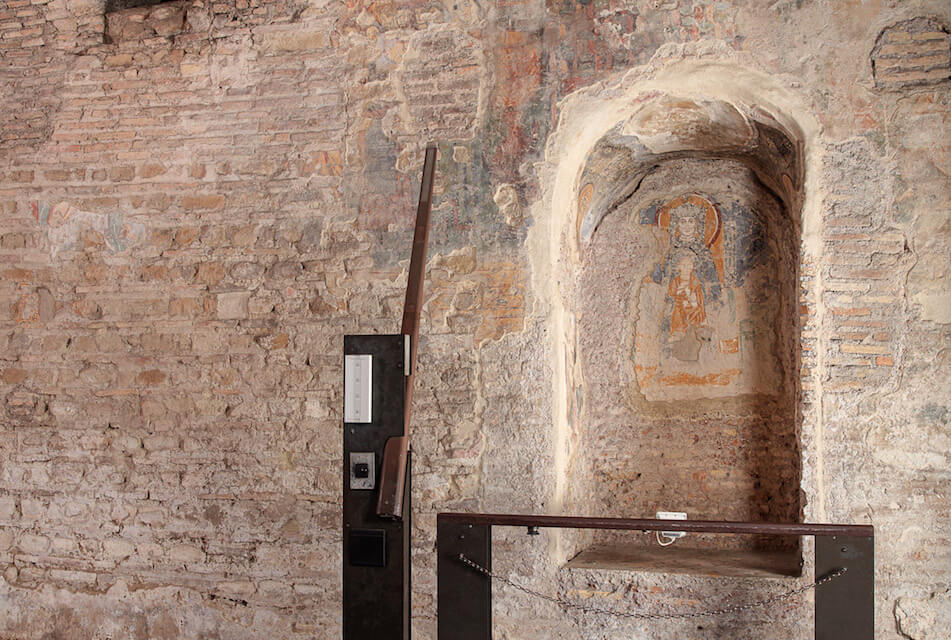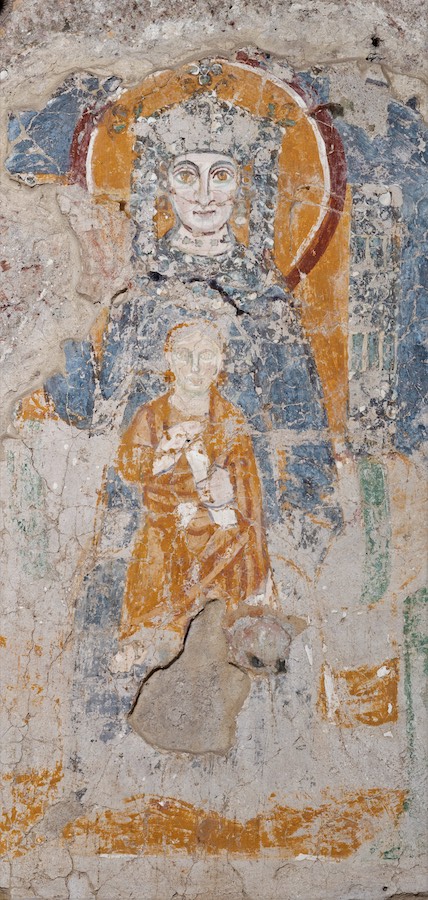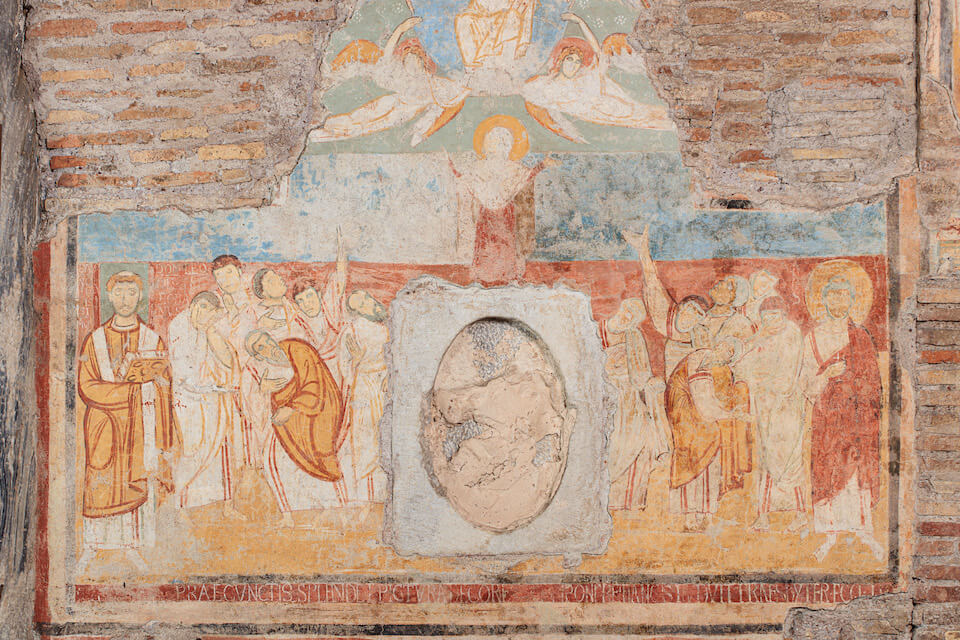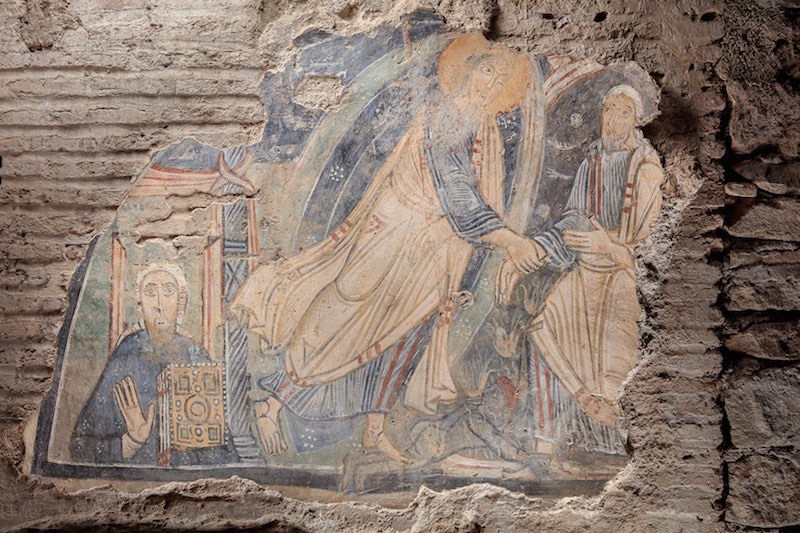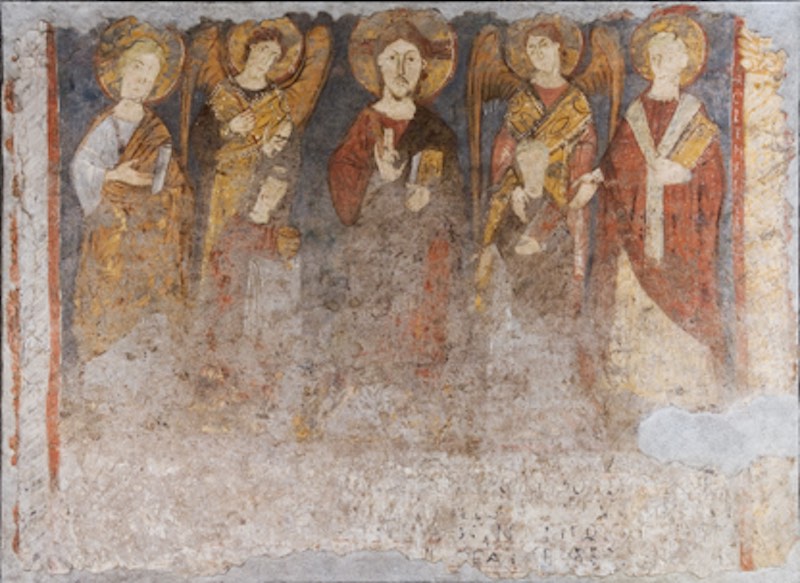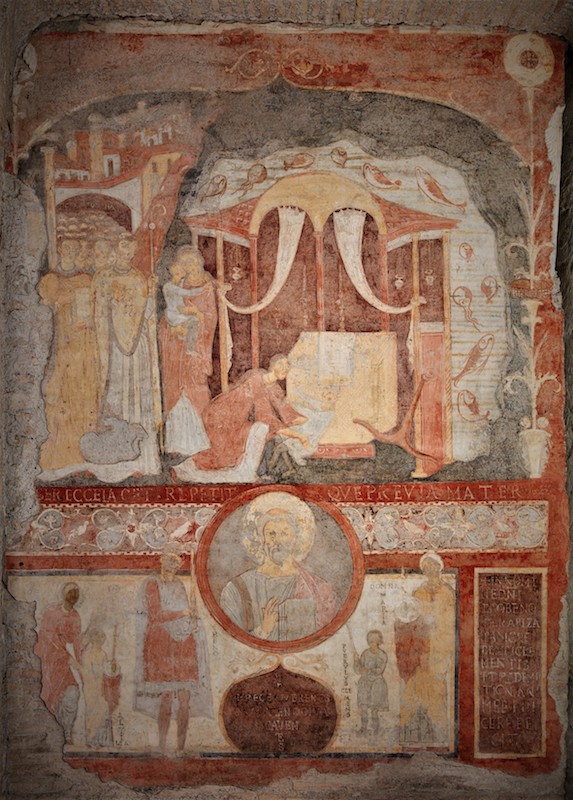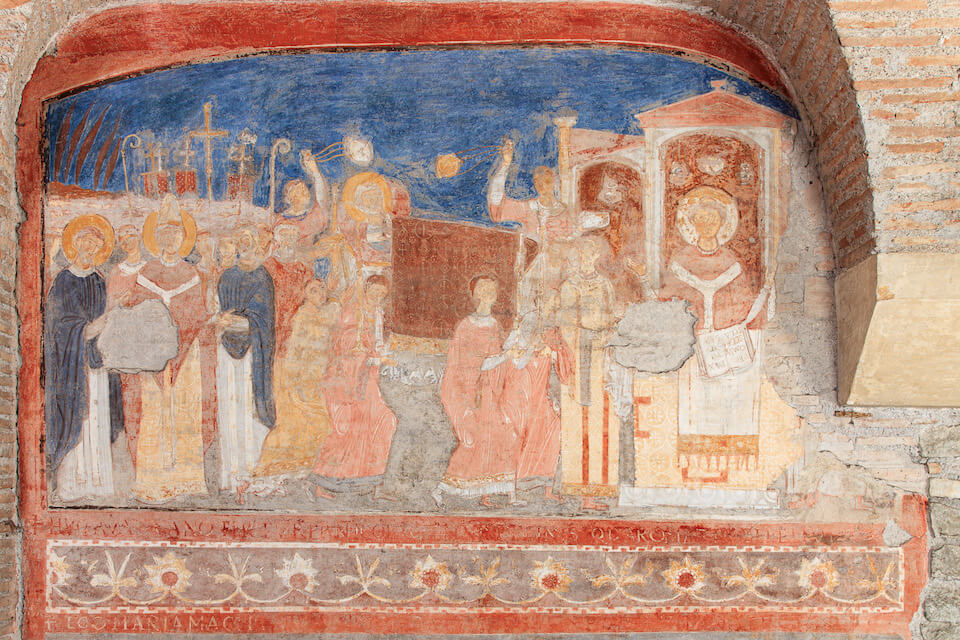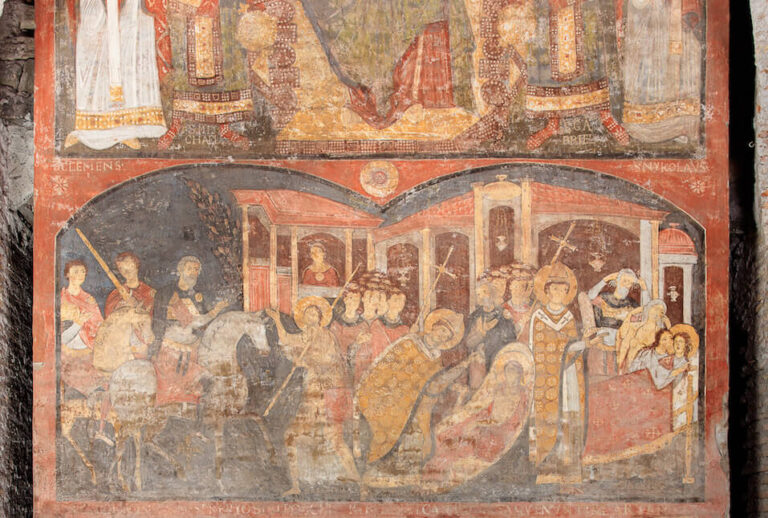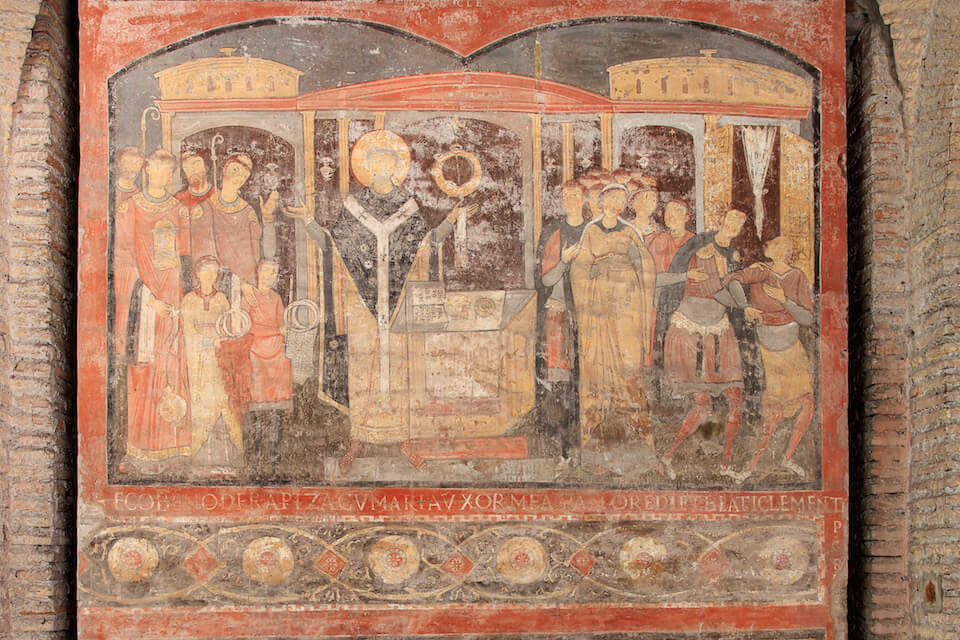The Frescos
The Frescos of the Lower
Basilica of San Clemente
One of the largest collections of early medieval wall-painting to have survived in the city of Rome is to be found in the lower church of San Clemente. These paintings were abandoned and forgotten for hundreds of years until, in the middle of the nineteenth century, they were brought to light by excavations undertaken by Fr Joseph Mullooly. Originally, the walls of San Clemente appear to have been completely covered in fresco. In many places only fragments of the original decoration remain, but some frescos, especially those painted in the 11th century, shortly before the lower church was abandoned, are wonderfully preserved.
Not only are these frescos valuable as sources of information for the art historian they also provide indispensable information regarding the dress, architecture and customs of people living in the Middle Ages. What is more, they speak with great vividness concerning the faith in Christ of these people and their veneration of the saints.
Work on the frescos continues. Their physical condition is continually monitored, new studies are being done on all of them, on the frescos described below, and on the others which are in a more fragmentary state, and also on the frescos which have more recently come to light in the new excavations.
The Madonna and Child -
A fresco of the 8th Century
sec. VIII
The wall along the north aisle was once completely covered in fresco. What still remains of this original decoration is now faded and fragmentary. Of the frescos on the wall, the largest area of painting to survive is a 10th century fresco of the General Judgement. There we see the faces of the blessed on one side of the niche in the wall and the torment of the damned on the other side.
The frescos inside the niche are much older than that of the General Judgement. Originally, when Fr Mullooly first broke through to the lower church, coming through where there is now a barred window high up on the wall, he found a fresco of the Madonna and Child Jesus set back within a niche. This fresco, after a few days, however, fell away from the wall, and an older fresco of the Madonna and Child, was revealed, the fresco that is now visible.
We see the Madonna and Child seated on a throne. Mary is dressed in blue and wears the elaborate headdress of a Byzantine empress, decorated with pearls. From frescos similar in character, it seems likely that Mary was holding a cross in her right hand. She wears long earrings, strings of pearls and a necklace of five jewels.
Jesus holds a scroll in his hand. Rather than simply telling a story, this fresco has something of the quality of an icon. Standing before it we find ourselves standing in the very presence of Mary and her Child.
On either side of the niche, in addition to the Madonna and Child, there are female saints, who are also richly attired with jewellery and pearls. The saint on the right has been identified from an inscription as St Euphemia; the figure on the left is unknown.
The Madonna and the Child Jesus were a frequent subject of early Christian art in Rome. What is particularly striking here is the jewelled crown on the head of the Madonna, inspired by the crown worn by a Byzantine empress. Mary is represented as a Queen, a form of representation which has a long history in Rome, exemplified by the 6th century Maria Regina fresco in Santa Maria Antiqua.
By comparing the Madonna and Child to other similar frescos in Roman churches, in particular with a now lost fresco of San Lorenzo fuori le mura, it is possible to date this San Clemente fresco to the 8th century. It is thought the two frescos may have been part of restoration work carried out in their respective churches by Pope Adrian I (722-795).
The Fresco of the Ascension
and other 9th Century Frescos
sec. IX
These frescos are found inside the main nave of the lower church, on the left of the entrance from the narthex.
The main scene shows the Ascension of Christ into heaven. The way in which the Ascension is here portrayed had already become standard by the 6th century. Christ is being borne aloft by angels, while the disciples, together with Our Lady in the centre, look on in wonder and amazement. The colours used in the fresco are mostly earth colours. With a few vivid strokes, the drama of the scene is communicated. Worth noting is the sky behind Mary. It was painted in a rare example of Egyptian Blue which gives us some idea of the original splendour of this particular fresco.
The vacant space under Mary possibly held a stone or relic from the Holy Land. St Vitus stands on the right of the scene and there is a contemporary portrait of Pope Leo IV (847-855) on the left. He is identified by an inscription: Sanctissimus Dom(inus) Leo Q(ua)rtus P(a)p(a) Romanus. The square nimbus behind his head indicates that it is a true likeness of Pope Leo. It means we can date the fresco to the time of his pontificate in the ninth century.
Underneath the Ascension scene, there are gaps in the plaster which would suggest the presence of a small altar and of marble panels which enclosed it. These indications, together with the presence of invocations in graffiti on the plaster, suggest that this was a small shrine, perhaps for the veneration of the relic which was once the centrepiece of the fresco.
Above and to the right there are some other ninth century frescos: the Crucifixion, the Women at the tomb of Christ, the Marriage Feast at Cana and the Descent into Limbo. Some of these are now barely visibly but we can identify the scenes from copies made at the time of the excavations. On the side of the same pillar, but partly obscured by the 12th century foundation wall, there is a fresco of St Prosper of Aquitaine, a secretary of Leo the Great.
The Anastasis or Descent into Hades -
a fresco of the 9th Century
sec. IX
This fresco is located at the northern side of the apse of the lower church in the narrow corridor formed by the foundation walls for the upper church. The theme of the painting is the Lord’s descent into Hell after his death, to free the just souls who had died before his work of Redemption. The dramatic account of this event is described in the 7th century apocryphal gospel of Nicodemus. It was an image of the conquest of Jesus over sin and death which was a popular theme in the Eastern Church where it was known as the Anastasis (Resurrection). We see Christ descending into a dungeon-like space, a place of darkness peopled by demon faces and by flames. Christ is carrying his cross like a victory standard. He takes hold of Adam by the wrist. The devil, clearly disturbed by this event, grabs Adam by the ankle but Christ steps on the devil, and thus delivers Adam once and for all from this dark underworld.
On the left side, separated from the scene by a twisted column there is the portrait of an Eastern monk. The figure raises his hand in acclamation and his right hand holds the scriptures. His head is framed by a square nimbus which indicates that it is a portrait of the person represented.
Although there is a New Testament text about this event – 1 Peter 3.19, ‘he went to preach to the spirits in prison’ – the late date of the apocryphal gospel which is the source of the imagery means that the scene appears relatively late in Christian art. It is possible that its arrangement may be influenced by ancient Roman classical scenes, one of which showed the emperor in triumph, carrying a spear and trampling the enemy and another where the emperor is raising a fallen figure intended to represent a province which had been newly liberated.
The figure on the left of the scene has recently attracted the interest of scholars. It was long recognised that this figure was a monk. The blue garment he wears, his beard and decorated hood indicate that he was an eastern monk. The square halo, though it was later used as a mark of distinction, here indicates that the painting is an accurate portrait likeness of the person. It is a funerary portrait. Closer examination of the surrounding walls reveals that the whole painting with the Descent of Christ and the portrait, were part of a large tomb, which consisted of a sarcophagus and a small arch surrounding the painting. The style and iconography all point to a date in the second half of the ninth century.
Recent scholarship has pointed out that the date, location, and presence of a portrait coincide with the descriptions of St Cyril’s tomb which we find in the ancient Life of Cyril. These state that St Cyril was buried in a tomb on the right-hand side of the altar, and that his portrait was painted over the tomb. The traditional site of St Cyril’s grave is in the south aisle of the basilica and is the place where his memory is venerated. This new theory suggests that St Cyril may in fact have been buried in the tomb for which this Anastasis fresco was painted. When the lower church was abandoned in the 12th century his relics were brought up to the new upper basilica where they are venerated today.
The Christ between angels and saints -
an 11th century fresco
sec. XI
This painting is situated between two pillars of the colonnade which stood between the Atrium and Narthex of the early basilica. It depicts Christ standing between the angels Michael and Gabriel and the saints Andrew and Clement. Christ gives his blessing in the Greek manner with thumb and finger joined and the other three fingers extended. In front of the angels are two smaller figures which are now barely visible. Formerly the fresco was known as “The Particular Judgement.” It was dated to the 9th century and the two smaller figures in front were identified as Cyril and Methodius. More recent scholarship has dated the painting to the 11th century. It seems to be part of a funerary monument. The saints and angels are presenting the two smaller figures, presumably those buried in the tomb underneath, to Christ the Lord.
On the left stands Saint Andrew, identified by an inscription now barely visible. St Andrew was venerated in Rome from very early times. Churches were dedicated to him, and he appears in Roman mosaics and frescos. There are in fact later sources which inform us that there were relics of Andrew in San Clemente. He holds a scroll in his left hand. St Clement stands on the right side of the group. He is identified by his name written “Clemente.” The presence of the Italian form of his name supports the later dating of the fresco. Clement holds the gospel book in his left hand while with his right hand he gestures to the small figures in front for whom he is interceding. While much of this fresco has now disappeared the copies which were made at the time of its discovery assist greatly in the dating and interpretation of the scene. The liturgical clothing, the style of ornamentation, and the manner in which the letters of the inscriptions were made, all point to it being a painting of a funerary monument of the eleventh century.
Two Frescos in the Narthex
from the 11th Century
The miracle of the sea of Azov
sec. XI
The first of the two paintings illustrates one of the miracle stories of St Clement. According to the Acta, the account of his martyrdom, he was banished to the Crimea in the reign of Trajan and forced to work in the mines. He was eventually martyred by being tied to an anchor and thrown into the Sea of Azov.
Sometime later the water receded, revealing a tomb which the local inhabitants could visit once a year. According to the legend a child was caught by the incoming tide in the tomb. Returning the following year, when the sea withdrew again, the child’s mother found that her son had survived miraculously in the tomb under the sea. The anchor, symbol of the martyrdom of St Clement, is on the right. The bishop and crowd coming from the nearby city of Kherson are astonished to see the child safe in his mother’s arms. A striking representation of the sea with various kinds of fish surround the scene.
On the panel below there is a circular medallion with a bust of St Clement who is being venerated by the doners of the fresco carrying candles: Beno de Rapiza, his wife Maria, their daughter Atilia and their son Clement. Beneath the picture of St Clement there is an inscription which is translated “seeking me in prayer, beware of hurtful things”.
The transfer of the remains of St Clement
Sec. XI
The other fresco at the entrance portrays the transfer of the body St Clement from St Peter’s to San Clemente. In 868 SS. Cyril and Methodius had brought the body of St Clement which they had found in the Crimea and presented it to the Pope.
The fresco shows the scene of the Pope bringing the body in procession to the church of San Clemente. At the centre we see the body of St Clement being carried on a bier. The two brothers SS. Cyril and Methodius with the Pope between them, lead the great crowd who are accompanying the body. The artist, however, has erred in giving the Pope’s name as Nicholas, for it was Pope Adrian II (867-872) who in fact received the missionaries.
The inscription tells us that this fresco, too, is the gift of the de Rapiza family: “I, Maria Marcellaria, for the reverence of God and the salvation of my soul, had this painted”. When this painting was discovered, it was in very poor condition and what we see today is the result of extensive restoration.
The 11th Century Frescos of the Central Nave
Two columns of the southern colonnade of the lower basilica were encased in walls in the 11th century. On these walls were painted two 11th century frescos at the same period of those in the narthex.
The Saint Alexis Fresco
sec. XI
This fresco tells the famous story of the ascetic Alexis, the son of a rich Roman senator. After his marriage and with his wife’s consent, he left Rome to become a hermit in Edessa in Syria. As the years went by, he become famous and much sought after for his holiness. So, seeking solitude, he fled Edessa and returned to Rome. This is where the fresco takes up the story.
Outside the family home he met his father who was returning on horseback (on the left). The father here seems to be modelled on the equestrian statue of Marcus Aurelius, now on the Capitol Hill but which, at the time the fresco was painted, was situated at the Lateran. The father did not recognise his son Alexis and neither did the wife of Alexis, here seen looking out one of the windows of their home. Alexis decided not to reveal who he was, but instead humbly accepted his father’s offer of hospitality and lived unrecognised as a servant in his own home, sleeping under a staircase. At his death, some years later, a paper was noticed in his hand. Only the Pope was able to release it from his grasp (centre of panel). We see the Pope standing reading the note which reveals the identity of Alexis. In the last scene, on the right, we see his sorrowing wife embracing his dead body while his parents, grief-stricken pull at their hair.
Above the fresco there is another panel, the upper part of which was destroyed when the floor of the 12th century basilica was being built. The scene can be identified as Christ on a throne between the angels Michael and Gabriel and the saints Clement and Nicholas. The lower panel is a highly decorative piece with flowers, fruit, and exotic birds. On the side of the pier there are two other panels which today are not easy to see, being obscured in part by the foundation wall of the basilica above. The scenes tell stories from the life of St Blaise, the top one showing him curing a boy who was choking on a fish bone.
A Fresco with the Mass of St Clement
and the story of Sisinnius
Sec. XI
This is perhaps the best-known fresco of the lower church of San Clemente. At a certain point during the excavations Fr Mullooly began to run out of funds and it seemed his work could not continue. Then he began excavating in the central nave and discovered this fresco. Its discovery caused great excitement across the world and the support he received enabled him to continue the work of excavating the lower church.
In the central panel we see St Clement celebrating Mass in his basilica. The church is laid out in great detail. The central nave, the two side aisles, the lamps, the altar with the book placed on it together with chalice and paten. St Clement looks out from the fresco, speaking as it were to us the words written in the book – The Lord be with you. The Peace of the Lord be with you. Behind Clement stand the clergy and the two small figures who are the donors of the painting. They are members of the de Rapiza family as we learn from the inscription underneath.
On the right-hand side of the fresco, we have one of the 5th century legends about St Clement. We see a servant leading the nobleman Sisinnius out of the church. He is the figure second from the right in the fresco. Sisinnius, a pagan, had secretly followed his wife Theodora to the church. As a pagan he should not have been present at the sacred mystery of the Mass. So, he was struck blind and deaf and became so disorientated that he could not find his way out of the church. Theodora saw what was happening and prayed for him. As a result, his servants succeeded in getting him out of the church and brought him home. On hearing from Theodora what had happened, St Clement, filled with pity for him, went to their home where he prayed to Christ the Lord who cured Sisinnius. Cured of his blindness, Sisinnius, was at once filled with anger at seeing Clement with his wife. Believing that Clement had somehow cast a spell on him, he ordered his servants to take him prisoner. The servants were, by a miracle, led to imagine that a column lying on the ground was Clement. They tied up the column and tried to drag it out of the house. We see the scene in the lower panel where Sissinius is ordering his servants to remove the column, thinking it is St Clement. The servants call out to each other and the words they speak are written beside them on the fresco.

This scene is often reproduced as the words are indeed famous. It marks the transition from Latin to Italian and, in the inscription, we have one of the earliest examples of written Italian. On the left, Falite dereto colo palo Carvoncelle (get behind with a lever Carvoncelle), Gosmari Albertel traite (Pull away, Gosmari and Albertel), and finally Sissinius, on the right, calls out Fili dele pute traite (sons of whores, pull away). To his persecutors, St Clement speaks the words inscribed under the arches – duritiam cordis vestris saxa traere meruistis (because of the hardness of your hearts you have merited to draw away stones). Here the story in the fresco ends but, in the legend, Sisinnius was later converted and, subsequently, died as a martyr for his faith.
In the topmost panel of this fresco there is part of another scene which was cut off by the pavement of the church above. Here St Clement is being enthroned as pope by St Peter, while his predecessors Linus and Cletus with other officials stand on either side.
As in the St Alexis fresco, the sides of the wall were also decorated with paintings which are now difficult to see, being partially hidden by the 12th century foundation wall. The scene of Daniel in the lions’ den is one which was popular from the earliest days of Christian art and is frequently found in the catacombs. An image of threat and violence, it strikingly recalls the suffering and martyrdom undergone by the early Christians for their faith.
See the publications of Professor John Osborne on the frescos of the lower church which are recommended for those seeking further information.

